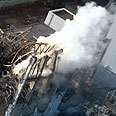
US naval barges loaded with freshwater sped toward Japan's overheated nuclear plant to help workers who scrambled Saturday to stem a worrying rise in radioactivity and remove dangerously contaminated water from the facility.
Workers at the stricken Fukushima Dai-ichi plant have been pumping seawater in a frantic bid to stabilize reactors overheating since a tsunami knocked out the complex's crucial cooling system March 11.
Plant operator Tokyo Electric Power Co. is rushing to use freshwater instead because of the corrosive potential of the salt in seawater, Hidehiko Nishiyama of Japan's Nuclear and Industry Safety Agency said at a briefing Saturday.
The switch was the latest tactic in attempts to regain control of the nuclear power plant near the coast, 140 miles (220 kilometers) northeast of Tokyo.
On Friday, nuclear safety officials revealed that they suspected a breach in one or more of the plant's units, possibly a crack or hole in the stainless steel chamber around a reactor core containing fuel rods or the concrete wall surrounding a pool where spent fuel rods are stored.
Suspicions were aroused when two workers suffered skin burns after unexpectedly encountering water that was 10,000 times more radioactive than levels normally found in the units, NISA said.
Such a breach could mean a much larger release of radioactive contaminants. The most likely consequence would be contamination of the groundwater, experts said.
No direct health risk
Following the announcement, government officials urged families in a voluntary evacuation zone between 12 and 19 miles (20 to 30 kilometers) from the plant to leave on their own.
Radioactivity was rising in some units due to contaminated water, Nishiyama said Saturday.
"It is crucial to figure out how to remove contaminated water while allowing work to continue," he said, acknowledging that the discovery would set back delicate efforts to get the plant's cooling system operating again.
Workers have begun pumping radioactive water from one of the units, Masateru Araki, a TEPCO spokesman, said Saturday.
Plant officials and government regulators say they don't know the source of the radioactive water. It could have come from a leaking reactor core, connecting pipes or a spent fuel pool. Or it may be the result of overfilling the pools with emergency cooling water.
But a breach in the chamber surrounding the core reactor seemed "more likely," Nishiyama said.
Tests of seawater just outside one unit tested some 1,250 times higher than normal, probably from both airborne radiation released from the reactors and contaminated water leaking into the sea, he said, adding that there was no immediate health risk.
Such levels are unlikely to pose a direct health risk to humans because they would not be expected to drink seawater or swim near the plant in these circumstances. This can affect the immediate marine environment, but the vast expanse of the sea will help dilute high levels of radiation.
'Urgent Request'
The switch to cooling reactors with freshwater was necessary because of fears salt and other contaminants in seawater were clogging up pipes and coating the surface of reactor vessels and fuel rods, hampering the cooling process, NISA said.
Defense Minister Yoshimi Kitazawa said late Friday that the US government had made "an extremely urgent" request to switch to freshwater. He said the US military was sending water to nearby Onahama Bay and would begin water injections early next week.
The Pacific Command confirmed Saturday that barges loaded with freshwater were dispatched to Fukushima.
Temperatures have stabilized in one unit, Unit 1, since the switch to freshwater, Nishiyama said Saturday.
The situation at the plant is not getting worse but vigilance is needed, Chief Cabinet Secretary Yukio Edano said on Saturday.
More than 700 engineers have been working in shifts to stabilise the facility and work has been advancing to restart water pumps to cool their fuel rods.
Two of the six reactors are now seen as safe but the other four are volatile, occasionally emitting steam and smoke. However, the nuclear safety agency said on Saturday that temperature and pressure in all reactors had stabilised.
- Follow Ynetnews on Facebook















